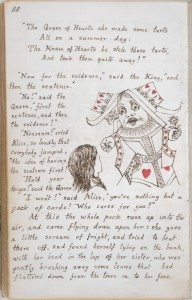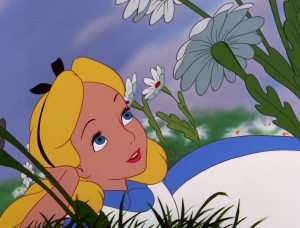150 years of Wonderland
[dropcap]S[/dropcap]ince they were written, Lewis Carroll’s Alice books have been delighting children and adults alike. They’ve been adapted countless times and have gained a place in pop culture that cannot be assailed. One of the most remarkable things about the books is their sheer madness. Considering that they were told orally to the Liddell children, they are complex, off-the-wall and nonsensical.
 One of the first things that you notice about the Alice books are the nonsense poems. These are often presented on the page as visual art, as well as verbal. “Tale” from Alice’s adventures in Wonderland, is actually written in the shape of a mouse’s tail, brining an extra level of sophistication to the story. When you combine this with the arresting imagery and situations that Carroll builds for Alice, it’s not hard to see why the books have become timeless. Instead of being mired in Victoriana, the adventures have transcended time and are still enjoyed today.
One of the first things that you notice about the Alice books are the nonsense poems. These are often presented on the page as visual art, as well as verbal. “Tale” from Alice’s adventures in Wonderland, is actually written in the shape of a mouse’s tail, brining an extra level of sophistication to the story. When you combine this with the arresting imagery and situations that Carroll builds for Alice, it’s not hard to see why the books have become timeless. Instead of being mired in Victoriana, the adventures have transcended time and are still enjoyed today.
Even the name has had an impressive legacy. Countless works of literature have used “Alice in…” to describe the start of a journey that parodies Carroll’s. People have looked to the future, the past, and even used the formula as a means to satirise education and government. It’s likely that Dorothy Gale, Wendy Darling and Lucy Pevensie all owe their journeys to Carroll, all being young girls reaching a fantasy world by means of an interesting entrance. Even now, literature is being extracted from Carroll’s original books. The latest offering, Alice Through the Quantum Glass, was published as recently as 2013.
One of the most remarkable things about the books is their sheer madness
In other mediums, people have been just as eager to mine the rich vein that is the Alice books. Walt Disney famously produced the iconic Alice in Wonderland in 1951, a film which blended both books into a trippy haze of colour and madness, which did justice to the insanity of the original. Less well-known are his live action Alice shorts, produced throughout the 1920s with Ub Iwerks. Betty Boop took a trip down the rabbit hole, as did the Care Bears. Carol Channing even famously took a turn as the White Queen in the 1985 TV movie.
 But not all adaptations have been good. Disney decided to produce a live-action sequel to the Alice movie in 2010. In trying to make it darker than the original, director Tim Burton unintentionally ruined the story and uniqueness of the material, turning it into another generic Young Adult fantasy romp that adds nothing to the legacy. The animated original is far superior.
But not all adaptations have been good. Disney decided to produce a live-action sequel to the Alice movie in 2010. In trying to make it darker than the original, director Tim Burton unintentionally ruined the story and uniqueness of the material, turning it into another generic Young Adult fantasy romp that adds nothing to the legacy. The animated original is far superior.
The same criticisms can be levelled at the American McGee Alice game and its sequel. Mcgee makes the same faux-pas of attempting to create extra darkness by giving Alice mental health problems and continuing her story. Although the idea is interesting, something is lost when the Alice books are tied to darker aesthetics.
She may not be a princess, but Alice finds her own way, and that’s a great message for the young at heart of any age.
The beauty of the series is the zaniness that it brings, and when the world is made forbidding and dark, both Alice and Wonderland lose their sense of wonder, which makes them what they are by definition. In the 150th year since the publication of these books, it’s clear that people aren’t going to leave the rabbit hole or step away from the looking glass any time soon. And that’s great. We need to show our kids fantasy that puts them in the role of protagonist. She may not be a princess, but Alice finds her own way, and that’s a great message for the young at heart of any age.
Image Credits: Header (www.flickr.com), Image 1 (sh.wikipedia.org), Image 2 (commons.wikimedia.org)

Comments